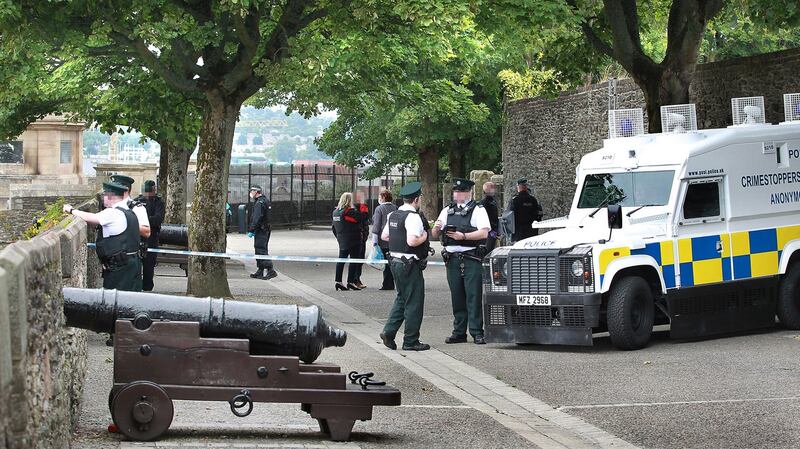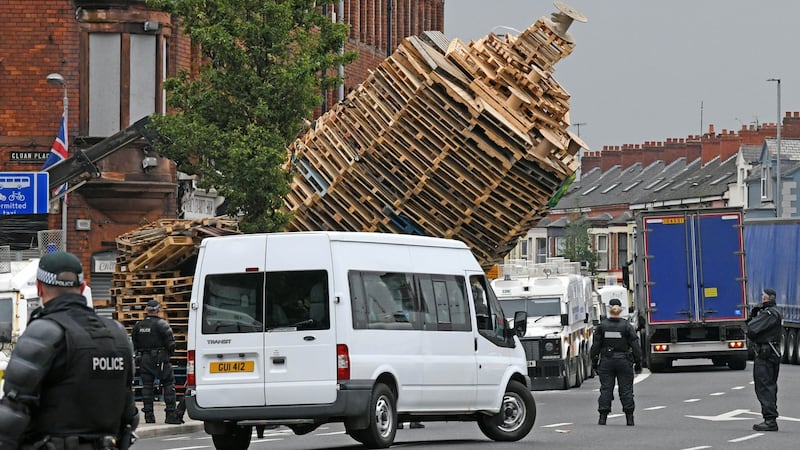Police are dealing with outbreaks of Eleventh Night trouble in Northern Ireland.
A senior PSNI officer warned on Wednesday night that the Ulster Volunteer Force (UVF) had threatened to foment "serious disorder" in east Belfast.
Police also said that a device that exploded near a sectarian flashpoint in east Belfast on Wednesday afternoon is believed to have been a pipe bomb.


Come on ffs...... attacking victims, threats based on religion...... burning the National flag of Ireland & electoral posters. This is not unionist culture. Absolutely pathetic. pic.twitter.com/dwBmvo18XP
— Doug Beattie (@BeattieDoug) July 11, 2018
Following reports of a “loud bang” in the Clandeboye Drive area of east Belfast, police said they found remnants of what they suspect was a pipe bomb. Sinn Féin said the incident was a sectarian attack.
The attack happened after police in riot gear moved in to protect masked contractors who had been directed to remove material from the nearby Cluan Place bonfire.
Later on Wednesday night a number of tyres were set alight in the Messines Road area of Newtownards, Co Down.
Police warned motorists to keep away from the area as they tried to deal with the incident.
Also on Wednesday night a bus was set alight in the loyalist West Winds estate area of Newtownards. None of the passengers on board the vehicles was injured, said police.
Eleventh Night sees hundreds of bonfires lit across Northern Ireland as part of traditional celebrations to mark the 1690 victory of Protestant King William of Orange over Catholic King James II at the Battle of the Boyne.
Orchestrate
As tensions mounted in the greater Belfast area ahead of the Twelfth of July parades due to disputes over loyalist bonfires, the PSNI assistant chief constable Alan Todd said he has received information that indicates that the UVF intended to "orchestrate and participate in serious disorder" in east Belfast on Wednesday night.
Mr Todd said the trouble was to be directed against his officers. “I would strongly urge people to desist from engaging in any violent or criminal behaviour. I would also appeal to those who have influence in this community to discourage people from taking part in any illegal activity,” he said.
“The safety of the public and my officers is of paramount importance and accordingly I will be reviewing my resourcing plans to ensure there is an appropriate and proportionate policing operation in place to deal with any disorder should it occur,” added Mr Todd.
Several huge unlit loyalist bonfires were dismantled on Wednesday by masked contractors operating under police protection.
Dismantled bonfires include two contentious ones at Bloomfield Way and Cluan Place in Belfast. Both structures, tall piles of wooden transport pallets and vehicle tyres, were close to property and efforts to negotiate their transfer to safer positions failed.
In what some observers in Northern Ireland saw as a shift in PSNI policy on the contentious issue of loyalist bonfires, streets were sealed off as contractors went in and pulled the structures apart.
Unionist reactions
The police action provoked differing reactions from unionists.
MLA member for Upper Bann Doug Beattie tweeted a photograph of a huge bonfire, topped by three Irish flags and sporting messages including "F*ck your Ballymurphy Massacre Inquiry", and KAT (Kill All Taigues [sectarian slang for Roman Catholics]).
With his tweet, he commented: “Come on ffs . . . attacking victims, threats based on religion . . . burning the National flag of Ireland & electoral posters. This is not unionist culture. Absolutely pathetic.”
However, the police action was attacked by Jamie Bryson, an influential loyalist blogger and activist, who described the dismantling of the Cluan Place bonfire as "Absolutely disgraceful. The difference in [the PSNI] kid glove approach to the Bogside is clear for all to see."
He was referring to disturbances in Derry between some residents of the mainly Catholic and republican Bogside and nearby loyalist Fountain area, where houses and murals have been attacked by nationalists in recent days.
Gunfire
On Tuesday, gunfire came from the Bogside and on Wednesday, police blamed what they called dissident republicans.
Events in Derry prompted a rare unified statement of condemnation from the DUP, Sinn Féin, Ulster Unionists, SDLP and Alliance parties in the city.
“Attacks on the police have been ongoing for a number of days alongside other violence including sectarian attacks on houses, petrol bombs thrown at the police, intimidation of contractors, vehicles hi-jacked and attacks on sheltered accommodation,” it said.
“The shots fired last night were a clear and obvious attempt to murder police officers. There must be a strong, clear and united voice against those who would engage in such disgraceful violence.
“As a society we must all stand with those who maintain law and order and who protect all sides of our community.”
Commenting on the removal of the Belfast bonfires, a PSNI spokesperson said: "The operations at Bloomfield Walk and Cluan Place are necessary to protect nearby buildings and residents who live in the areas."
Officers said rumours that wood would be removed at other sites were unfounded.
Injunction
On Tuesday morning, Belfast City Council urged the bonfire builders to remove excess material, saying it had been measured and it was too tall. The council applied to Belfast High Court for an injunction to force the Department for Infrastructure, which owns the land the bonfire is built on, to reduce the height of the pyre.
Mrs Justice Keegan directed the department to take immediate steps amid claims the controversial 80 pallet-high construction posed a serious threat to surrounding homes.
PSNI chief constable George Hamilton tweeted: "Unfortunate display of reckless behaviour Bloomfield Walkway this morning – attacking Police & damaging homes of local residents. So called loyalist expressing their culture and tradition – not reflective of vast majority of great people in East Belfast."
In 2015 more than 50 homes close to the Walkway bonfire were boarded up to protect them from the heat generated when it was lit.
The site of the bonfire had been moved in the past two years amid community concern about its proximity to houses.














